HUTTON, John
John Campbell Hutton was born at Clyde on the South Island of New Zealand on 8 August 1906. He attended Wanganui Collegiate School 1920-1922, and after studying law for several years which he abandoned and, despite not having any formal art training, took up as a professional artist. He married in 1934, fellow artist [[Helen [Nell] Blair,5516]], and together, they embarked on a successful and prolific collaborative relationship holding a joint exhibition in Wellington in 1936 before relocating to the UK, and Hutton developing an interest in mural painting, worked for the Paris Exhibition of 1937, and on mural paintings for the Orient line 'Orcades'. In 1939 living in a commune at Assington Hall, Further Street, Great Waldingfield, Suffolk with his wife Nell and son Warwick Hutton and his twin, Macaillan Hutton, later an architect they had a further son Peter Hutton, a teacher. John worked on several mural commissions until the outbreak of the Second World War, when he enlisted in a camouflage unit where he met and worked with the architect Basil Spence (1907-1976). In 1947 he designed his first large scale glass engravings with a series of four panels depicting the seasons for the restaurant area on the Cunard ship 'Caronia' and by 1953 he had developed a unique method of engraving using a grinding wheel attached to a flexible drive. On 7 April 1949, the Huttons' moved to Landermere Creek, near Thorpe-le-Soken, Essex, living firstly at the 'King’s Head' before renting from psychoanalyst Karin Stephen (1890-1953), moving into one of the Gull Cottages, where he had a glass studio in the garden which Eduardo Paolozzi (1924-2005) had used to make his sculptures. John and Nell continued to work and exhibit together in England even after their divorce in 1960. John employed as an artist's model, Marigold Elizabeth Mary Dodson (born 1931), to pose for many of the figures in his artwork and, after his first marriage ended, in 1963 he married Marigold at Hampstead, London but continued to work on joint art projects with his former wife. John and Marigold had one daughter, Katie. The 1954 east window in Southwold church, the last work by Ninian Comper (1864-1960) and the engraved figure of St Edmund, in a memorial window to the Tennyson family, was completed by Hutton, shortly before the dedication service. In 1975 he became first Vice-President of the newly founded Guild of Glass Engravers and his windows are in buildings all over the world and his glass engravings, paintings, and murals in global national collections. He continued working until he finally succumbed to cancer and John Campbell Hutton died at Studio Barn, Oxford Road, Clifton Hampden, Abingdon on 28 July 1978. His ashes were buried beneath a stone at the foot of one of his finest works, the screen at Coventry Cathedral. In 2016 his wife Marigold was still living at Abingdon, Oxfordshire with her now married daughter, Katherine [Glasby].
Note:
In 1956 John Hutton produced a graffito image showing the four elements, earth, air, fire, and water, commissioned by architect Birkin Haward. It was in the stairwell of the main building of Fison's Levington Research Station, near Ipswich which, despite the ministrations of several ex-Fison's employees, was destroyed in the 1980s. In 1961 Birkin Haward again asked him to produce three engraved glass panels for the Foyer of Fison House in Princes Street, Ipswich. They represented the Roman goddesses Flora, Pomona, and Ceres. After Fisons had moved out of the building, the panels were removed by a builder, who destroyed the Ceres panel and managed to break the Pomona panel in half. Marigold Hutton purchased the panels and found a glass conservator, Kenneth Watt, in Chichester who restored them. Marigold intends to display the panels in Clifton Hampden. A third Ipswich work was a ceramic produced in collaboration with his former wife Nell which was commissioned by the former Eastern Electricity Board for their Russell Road headquarters in Ipswich in 1966. This is believed lost.
Works by This Artist
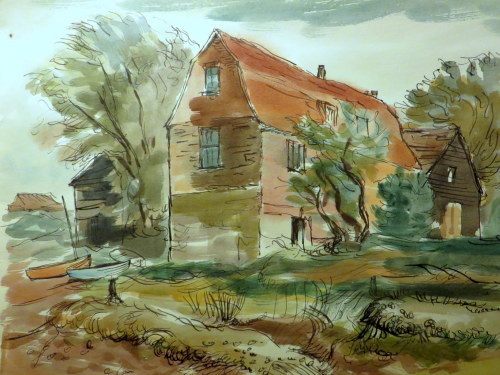
|
A Sketch of LandermereWatercolour |
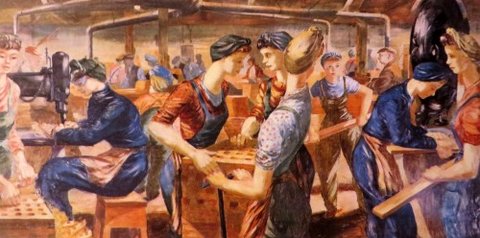
|
Women At WarMural for Crosby & Company Ltd
|
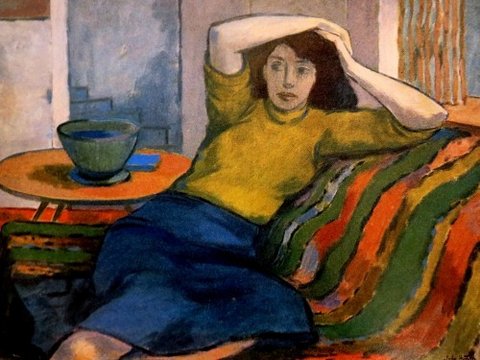
|
Nell Hutton at LandermereOil on canvas |
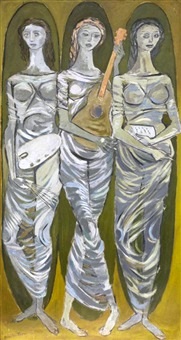
|
Three MusesOil on board
|
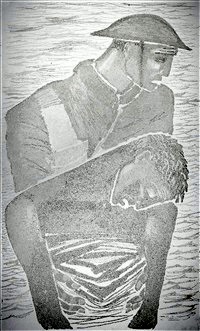
|
Retreat from DunkirkEngraved glass window
|